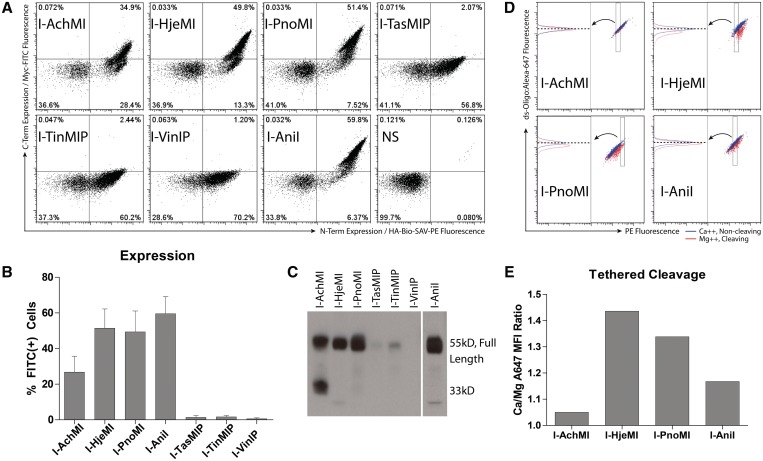Figure 2.
LHE characterization by flow cytometry. (A) Expression of full-length protein, determined by flow cytometry in a representative experiment. Staining against a C-terminal epitope tag and associated measured fluorescence intensity (Y-axis) and N-terminal epitope tag (X-axis) allows qualitative and quantitative assessment of surface expression. I-TasMIP, I-TinMIP and I-VinIP show minimal full-length protein (quadrant I and dual-positive), indicating reduced thermostability and/or poor folding. (B) Percentage of expressing (dual-positive) cells, as in panel (A), is summarized for five replicates (three for I-TasMIP, I-TinMIP and I-VinIP) with standard deviation plotted. (C) A western blot using antibodies against the N-terminal epitope tag allowed visualization of full length and truncated protein. Much of I-AchMI was expressed as ∼33 kDa protein fragment. Only minimal full-length protein and primarily heterogeneously truncated I-TasMIP, I-TinMIP and I-VinIP products were expressed, while I-Hje, I-PnoMI and I-AniI were primarily full length and in great abundance. (D) Demonstration of the gating strategy used to normalize substrate for the flow cleavage assay. These displayed populations are already normalized for enzyme concentration by a uniform, narrow FITC (C-terminal epitope) gate (data not shown). Equivalent amounts of tethered dsOligo across samples was selected by finding a streptavidin–PE level (rectangle) for each sample for which all DNA-A647 median fluorescence intensities (dashed horizontal line) were equal in the Ca++ sample (blue population). This gate was held constant for the matched pair Mg++ sample (red population), allowing quantification of magnesium-dependent loss of the DNA-conjugated fluorophore. The left half of the plot shows the population in the rectangular PE gate from the right plot (follow arrow). (E) Dividing the median Alexa647 fluorescence intensity of the calcium-containing sample (blue) by that of the magnesium-containing sample (red) yields a ratio proportional to the amount of enzymatic activity for a given LHE.

